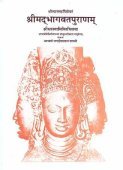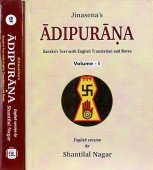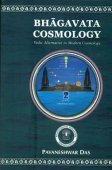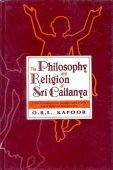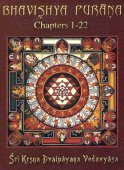Bhagavata, Bhāgavata: 18 definitions
Introduction:
Bhagavata means something in Hinduism, Sanskrit, the history of ancient India, Marathi. If you want to know the exact meaning, history, etymology or English translation of this term then check out the descriptions on this page. Add your comment or reference to a book if you want to contribute to this summary article.
In Hinduism
Purana and Itihasa (epic history)
Source: archive.org: Puranic EncyclopediaBhāgavata (भागवत).—One of the eighteen famous Purāṇas. Gāyatrī is the main theme of this Purāṇa and based on it it dwells on the greatness of Dharma (duty) and states about the dharmas of Sārasvatakalpa. (See under Purāṇa).
Source: Cologne Digital Sanskrit Dictionaries: The Purana Index1a) Bhāgavata (भागवत).—A son of Vajramitra and father of Devabhūti: ruled for 32 years.*
- * Bhāgavata-purāṇa XII. 1. 18; Brahmāṇḍa-purāṇa III. 74. 154; Viṣṇu-purāṇa IV. 24. 35-6.
1b) Those who had dedicated themselves to the service of God by singing in His praise.*
- * Vāyu-purāṇa 104. 14.

The Purana (पुराण, purāṇas) refers to Sanskrit literature preserving ancient India’s vast cultural history, including historical legends, religious ceremonies, various arts and sciences. The eighteen mahapuranas total over 400,000 shlokas (metrical couplets) and date to at least several centuries BCE.
Pancaratra (worship of Nārāyaṇa)
Source: eScholarship: Chapters 1-14 of the Hayasirsa PancaratraBhāgavata (भागवत) refers to an archaic designation of an ancient Bhakti cult.—At the time of their composition, many texts from the various sects who saw Viṣṇu as the highest god were not grouped under a common term, like Vaiṣṇava, as we are used to grouping them. Banerjea asserts that the Pādma Tantra says (in Banerjea’s translation): “Sūri, Suhṛt, Bhāgavata, Sātvata, Pañcakālavit, Ekāntika, Tanmaya and Pāñcarātrika are different designations of this Bhakti cult”. Banerjea also points out that the term Vaiṣṇava is absent.
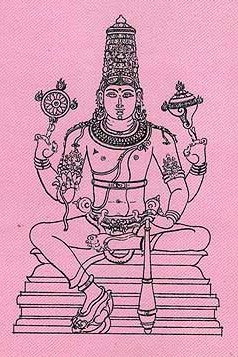
Pancaratra (पाञ्चरात्र, pāñcarātra) represents a tradition of Hinduism where Narayana is revered and worshipped. Closeley related to Vaishnavism, the Pancaratra literature includes various Agamas and tantras incorporating many Vaishnava philosophies.
Jyotisha (astronomy and astrology)
Source: Wisdom Library: Brihat Samhita by VarahamihiraBhāgavata (भागवत) refers to a “great devotee” [?], according to the Bṛhatsaṃhitā (chapter 15) (“On the nakṣatras—‘asterisms’”), an encyclopedic Sanskrit work written by Varāhamihira mainly focusing on the science of ancient Indian astronomy astronomy (Jyotiṣa).—Accordingly, “Those who are born on the lunar day of Uttarāṣāḍha will be chief ministers or wrestlers; will keep elephants and horses, will be religious; will be men of principles; soldiers; happy and of bright appearance. Those who are born on the lunar day of Śravaṇa will be cunning, of active habits, efficient workmen, bold, virtuous, god-fearing (bhāgavata) and truthful”.

Jyotisha (ज्योतिष, jyotiṣa or jyotish) refers to ‘astronomy’ or “Vedic astrology” and represents the fifth of the six Vedangas (additional sciences to be studied along with the Vedas). Jyotisha concerns itself with the study and prediction of the movements of celestial bodies, in order to calculate the auspicious time for rituals and ceremonies.
General definition (in Hinduism)
Source: Wisdom Library: HinduismBhāgavata (भागवत), 'the great devotee' or 'the most powerful' or 'a worshiper of the Adorable One'.
Source: WikiPedia: HinduismBhagavata signifies in the context of Hinduism. In this context bhakti has the primary meaning of 'adoration', while Bhagavat means 'the Adorable One', and Bhagavata is a worshiper of the Adorable One. It also refers to a tradition devoted to worship of Krishna, later assimilated into the concept of Narayana or original form svayam bhagavan. According to some historical scholars, worship of Krishna emerged in the 1st century BC. However, Vaishnava traditionalists place it in 4th century BC. Despite relative silence of the earlier Vedic sources, the features of Bhagavatism and principles of monotheism of Bhagavata school unfolding described in the Bhagavad Gita as viewed as an example of the belief that Vasudeva-Krishna is not an avatar of the Vedic Vishnu, but is the Supreme.
etymology: Bhagavata (Bhāgavata, a vrddhi formation from Bhagavan, meaning "pertaining to Bhagavan" ("the Lord", i.e. God)")
India history and geography
Source: Cologne Digital Sanskrit Dictionaries: Indian Epigraphical GlossaryBhāgavata.—(LL), a votary of the Bhagavat (Viṣṇu). (CII 3; etc.), a Vaiṣṇava sect. Note: bhāgavata is defined in the “Indian epigraphical glossary” as it can be found on ancient inscriptions commonly written in Sanskrit, Prakrit or Dravidian languages.

The history of India traces the identification of countries, villages, towns and other regions of India, as well as mythology, zoology, royal dynasties, rulers, tribes, local festivities and traditions and regional languages. Ancient India enjoyed religious freedom and encourages the path of Dharma, a concept common to Buddhism, Hinduism, and Jainism.
Languages of India and abroad
Marathi-English dictionary
Source: DDSA: The Molesworth Marathi and English Dictionarybhāgavaṭā (भागवटा).—m bhāgalīka f W (bhāgaṇēṃ) Fatigue, weariedness, exhausted or spent state.
--- OR ---
bhāgavata (भागवत).—a (S) Relating to bhagavat. 2 That walks according to the bhāgavatapurāṇa, and pays equal honor to viṣṇu & śiva.
--- OR ---
bhāgavata (भागवत).—n (S) The name of one of the aṭharā- purāṇa. See the enumeration under purāṇa.
Source: DDSA: The Aryabhusan school dictionary, Marathi-Englishbhāgavaṭā (भागवटा).—m bhāgalīka f Fatigue, wearredness.
Marathi is an Indo-European language having over 70 million native speakers people in (predominantly) Maharashtra India. Marathi, like many other Indo-Aryan languages, evolved from early forms of Prakrit, which itself is a subset of Sanskrit, one of the most ancient languages of the world.
Sanskrit dictionary
Source: DDSA: The practical Sanskrit-English dictionaryBhāgavata (भागवत).—a. (-tī f.) [भगवतः भगवत्या वा इदं सोऽस्य देवता वा अण् (bhagavataḥ bhagavatyā vā idaṃ so'sya devatā vā aṇ)]
1) Relating to or worshipping Viṣṇu.
2) Pertaining to a god; कौमारादाचरेत् प्राज्ञो धर्मान् भागवतानिह (kaumārādācaret prājño dharmān bhāgavatāniha)
3) Holy, divine, sacred.
-taḥ A follower or devotee of Viṣṇu or Kṛṣṇa.
-tam Name of one of the 18 Purāṇas.
Source: Cologne Digital Sanskrit Dictionaries: Shabda-Sagara Sanskrit-English DictionaryBhāgavata (भागवत).—f. (-tī) Adj. 1. Relating to or worshipping of Vishnu or Krish- Na. 2. Holy, sacred. m.
(-taḥ) A devotee of the said deity. n.
(-taṃ) Name of one of the eighteen Puranas.
Source: Cologne Digital Sanskrit Dictionaries: Cappeller Sanskrit-English DictionaryBhāgavata (भागवत).—[feminine] ī relating to Bhagavant (Viṣṇu), [masculine] a follower of Bh.; [neuter] = seq.
Source: Cologne Digital Sanskrit Dictionaries: Aufrecht Catalogus CatalogorumBhāgavata (भागवत) as mentioned in Aufrecht’s Catalogus Catalogorum:—See Ekanāthabhāgavata, Jaiminibhāgavata, Devībhāgavata, Bālabhāgavata, Bhagavatībhāgavata, Mahābhāgavata.
Source: Cologne Digital Sanskrit Dictionaries: Monier-Williams Sanskrit-English Dictionary1) Bhāgavata (भागवत):—[=bhāga-vata] a See sub voce
2) [from bhāga] b mf(ī)n. ([from] bhaga-vat) relating to or coming from Bhagavat id est. Viṣṇu or Kṛṣṇa, holy, sacred, divine, [Mahābhārata; Harivaṃśa; Purāṇa]
3) [v.s. ...] m. a follower or worshipper of Bh° or Viṣṇu, [ib.] (cf. [Indian Wisdom, by Sir M. Monier-Williams 321, 1])
4) [v.s. ...] Name of a king, [Viṣṇu-purāṇa]
5) [v.s. ...] n. Name of a Purāṇa (cf. bhāgavata-p).
Source: DDSA: Paia-sadda-mahannavo; a comprehensive Prakrit Hindi dictionary (S)Bhāgavata (भागवत) in the Sanskrit language is related to the Prakrit word: Bhāgavaya.
[Sanskrit to German]
Sanskrit, also spelled संस्कृतम् (saṃskṛtam), is an ancient language of India commonly seen as the grandmother of the Indo-European language family (even English!). Closely allied with Prakrit and Pali, Sanskrit is more exhaustive in both grammar and terms and has the most extensive collection of literature in the world, greatly surpassing its sister-languages Greek and Latin.
Kannada-English dictionary
Source: Alar: Kannada-English corpusBhāgavata (ಭಾಗವತ):—[adjective] relating to a god, esp. to Viṣṇu.
--- OR ---
Bhāgavata (ಭಾಗವತ):—
1) [noun] a staunch follower of the sect that worship Viṣṇu.
2) [noun] a man who teaches, trains yakṣagāna (a genre of dance drama, having themes selected from epics) and directs its presentation.
3) [noun] one of the eighteen Purāṇas, and the most popular one among them, dedicated to the glorification of Viṣṇu.
Kannada is a Dravidian language (as opposed to the Indo-European language family) mainly spoken in the southwestern region of India.
See also (Relevant definitions)
Starts with (+65): Bhagavata krishna kavi, Bhagavata Purana, Bhagavata shankhya, Bhagavata trivikrama, Bhagavata vallata, Bhagavata vinitadeva, Bhagavata vinka, Bhagavata-tatparya-nirnaya, Bhagavatabhavarthadipika, Bhagavatacampu, Bhagavatacandracandrika, Bhagavatachampu, Bhagavatacurnika, Bhagavatadharma, Bhagavataditantra, Bhagavatagitavali, Bhagavataharishastri, Bhagavatajyotihshastrayorbhugolakhagolavirodhaparihara, Bhagavatakathasamgraha, Bhagavatakaumudi.
Ends with (+2): Abhinavabhagavata, Adhyatmabhagavata, Anubhagavata, Balabhagavata, Bhagavatibhagavata, Caitanyabhagavata, Catuhshlokibhagavata, Danabhagavata, Devibhagavata, Ekanathabhagavata, Jaiminibhagavata, Jitam-bhagavata, Laghubhagavata, Mahabhagavata, Mantrabhagavata, Parama-bhagavata, Saptashlokibhagavata, Shivabhagavata, Shribhagavata, Shrimadbhagavata.
Full-text (+10757): Ksharakardama, Sukaramukha, Shaunaka, Bhalabhola, Shivabhagavata, Dhumraketu, Valsha, Shukadeva, Shrimad Bhagavatam, Giritra, Tapasya, Gopigita, Nasti, Dashalakshana, Sudhriti, Devahu, Krimibhojana, Sambhoja, Bhagavatam, Satvat.
Relevant text
Search found 135 books and stories containing Bhagavata, Bhāgavata, Bhāgavaṭā, Bhaga-vata, Bhāga-vata; (plurals include: Bhagavatas, Bhāgavatas, Bhāgavaṭās, vatas). You can also click to the full overview containing English textual excerpts. Below are direct links for the most relevant articles:
Shri Gaudiya Kanthahara (by Srila Bhaktisiddhanta Sarasvati)
Chaitanya Bhagavata (by Bhumipati Dāsa)
Verse 3.3.532 < [Chapter 3 - Mahāprabhu’s Deliverance of Sarvabhauma, Exhibition of His Six-armed Form, and Journey to Bengal]
Verse 3.3.530-531 < [Chapter 3 - Mahāprabhu’s Deliverance of Sarvabhauma, Exhibition of His Six-armed Form, and Journey to Bengal]
Verse 2.14.21 < [Chapter 14 - Yamarāja’s Saṅkīrtana]
Brihad Bhagavatamrita (commentary) (by Śrī Śrīmad Bhaktivedānta Nārāyana Gosvāmī Mahārāja)
Verse 1.1.20-23 < [Chapter 1 - Bhauma (the earthly plane)]
Verse 2.3.124 < [Chapter 3 - Bhajana (loving service)]
Verse 2.4.241 < [Chapter 4 - Vaikuṇṭha (the spiritual world)]
A History of Indian Philosophy Volume 2 (by Surendranath Dasgupta)
Part 12 - Bhāgavata and the Bhagavad-gita < [Chapter XIV - The Philosophy of the Bhagavad-gītā]
Part 12 - Viṣṇu, Vasudeva and Kṛṣṇa < [Chapter XIV - The Philosophy of the Bhagavad-gītā]
Part 29 - Madhusūdana Sarasvatī (a.d. 1500) < [Chapter XI - The Śaṅkara School of Vedānta (continued)]
Parama Samhita (English translation) (by Krishnaswami Aiyangar)
The Bhāgavata religion coeval with Jainism and Buddhism < [Introduction]
The Bhāgavata religion of the Pāñcarātras < [Introduction]
Bhajana-Rahasya (by Srila Bhaktivinoda Thakura Mahasaya)
Related products
(+2 more products available)
